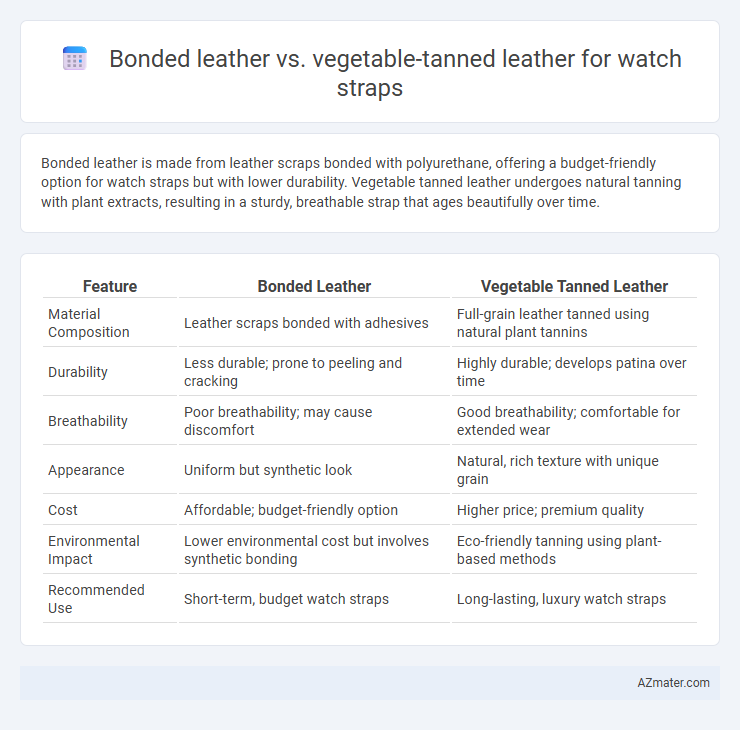Bonded leather is made from leather scraps bonded with polyurethane, offering a budget-friendly option for watch straps but with lower durability. Vegetable tanned leather undergoes natural tanning with plant extracts, resulting in a sturdy, breathable strap that ages beautifully over time.
Table of Comparison
| Feature | Bonded Leather | Vegetable Tanned Leather |
|---|---|---|
| Material Composition | Leather scraps bonded with adhesives | Full-grain leather tanned using natural plant tannins |
| Durability | Less durable; prone to peeling and cracking | Highly durable; develops patina over time |
| Breathability | Poor breathability; may cause discomfort | Good breathability; comfortable for extended wear |
| Appearance | Uniform but synthetic look | Natural, rich texture with unique grain |
| Cost | Affordable; budget-friendly option | Higher price; premium quality |
| Environmental Impact | Lower environmental cost but involves synthetic bonding | Eco-friendly tanning using plant-based methods |
| Recommended Use | Short-term, budget watch straps | Long-lasting, luxury watch straps |
Introduction: Choosing the Right Leather for Watch Straps
Bonded leather consists of leather scraps bonded together with adhesives, offering an affordable and uniform appearance but lower durability compared to vegetable tanned leather. Vegetable tanned leather undergoes a natural tanning process using tannins from plant matter, resulting in a durable, breathable, and patina-developing strap ideal for luxury watches. Selecting between bonded and vegetable tanned leather affects the watch strap's longevity, comfort, and aging characteristics.
What is Bonded Leather?
Bonded leather, used in watch straps, is a composite material made by blending shredded genuine leather fibers with polyurethane or latex onto a fabric backing, providing an affordable leather-like appearance. Unlike vegetable tanned leather, which is crafted from natural animal hides treated with plant-based tannins for durability and patina development, bonded leather lacks the same breathability and strength. Bonded leather straps may wear out faster and peel over time, making vegetable tanned leather a preferred choice for long-lasting, premium watch bands.
What is Vegetable Tanned Leather?
Vegetable tanned leather is crafted using natural tannins extracted from tree bark, leaves, and other plant sources, resulting in a durable and eco-friendly material ideal for watch straps. This traditional tanning process preserves the leather's strength and develops a rich patina over time, enhancing the aesthetic appeal and longevity of the strap. Compared to bonded leather, which consists of leather scraps glued together, vegetable tanned leather offers superior breathability, comfort, and a premium feel essential for high-quality watch straps.
Manufacturing Process: Bonded vs Vegetable Tanned Leather
Bonded leather watch straps are produced by recycling leather scraps mixed with adhesives and then compressed into sheets, offering an affordable but less durable option. Vegetable tanned leather undergoes a meticulous tanning process using natural tannins from tree bark, resulting in a robust, long-lasting, and environmentally friendly material. The vegetable tanning process enhances leather's aging characteristics, providing unique patina and increased resistance compared to the composite structure of bonded leather.
Durability and Longevity Comparison
Vegetable tanned leather offers superior durability and longevity for watch straps due to its natural tanning process, which results in a robust and flexible material that develops a unique patina over time. Bonded leather, made from leather scraps glued together, tends to wear out quickly, showing cracks and peeling after prolonged use. For long-lasting watch straps that improve with age, vegetable tanned leather is the preferred choice.
Comfort and Feel on the Wrist
Vegetable tanned leather watch straps offer superior comfort and a luxurious feel on the wrist due to their natural breathability and ability to mold to the skin over time. Bonded leather, made from leather scraps bonded together, tends to be less breathable and may feel stiffer or synthetic, causing discomfort during prolonged wear. The durability and aging process of vegetable tanned leather further enhance wrist comfort, making it a preferred choice for watch strap enthusiasts seeking long-term softness and flexibility.
Aesthetic Appeal and Aging Characteristics
Bonded leather watch straps offer a uniform appearance but tend to lack the natural grain and rich patina found in vegetable tanned leather. Vegetable tanned leather develops a unique, warm patina over time, enhancing its aesthetic appeal with age and showcasing individual character through natural wear. The aging characteristics of vegetable tanned leather contribute to a more luxurious and personalized look compared to the consistent but less dynamic appearance of bonded leather.
Environmental Impact and Sustainability
Vegetable tanned leather, derived from natural tannins in tree bark and plants, offers superior biodegradability and a lower environmental footprint compared to bonded leather, which is composed of leather scraps mixed with synthetic materials and adhesives. The production of bonded leather typically involves chemical processes and non-biodegradable components, contributing to increased waste and pollution. For sustainable watch straps, vegetable tanned leather supports eco-friendly practices through renewable resources and reduced chemical usage.
Price Differences and Value for Money
Bonded leather watch straps are significantly cheaper than vegetable tanned leather due to their composite material nature and lower durability. Vegetable tanned leather offers superior longevity, natural patina development, and breathability, justifying its higher price with long-term value. While bonded leather may appeal to budget-conscious buyers, vegetable tanned leather provides a better investment for quality and comfort.
Which Leather is Best for Your Watch Strap?
Vegetable tanned leather offers superior durability, breathability, and natural aging characteristics, making it the best choice for a long-lasting watch strap. Bonded leather, composed of leather scraps bonded with adhesives, is more affordable but less durable and prone to wear and cracking over time. For a high-quality, comfortable, and sustainable watch strap, vegetable tanned leather is the optimal material.

Infographic: Bonded leather vs Vegetable tanned leather for Watch strap
 azmater.com
azmater.com